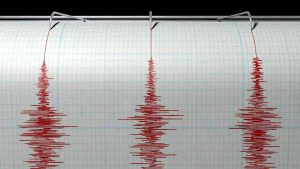
The season that an earthquake occurs could affect the extent of ground failure and destruction that the event brings, according to a new look at two historical earthquakes that occurred about 100 years ago near Almaty, Kazakhstan.
In a paper published in Seismological Research Letters, researchers conclude that the June 1887 magnitude 7.3 Verny earthquake and the nearby January 1911 magnitude 7.8 Kemin earthquake likely produced similar shaking. However, the 1911 earthquake caused significantly more ground failure, probably due to a shallow frozen ground layer that was present during the winter months.
The frozen layer may have inhibited the drainage of pore-pressure excess through the surface during the earthquake, causing liquefaction at depth. In effect, the frozen layer extending about one meter below the surface “was a sealant layer that was not allowing the pore pressure to diffuse,” explained Stefano Parolai, a co-author of the paper at the Istituto Nazionale di Oceanografia e di Geofisica Sperimentale in Italy.
The findings suggest seismologists should incorporate potential seasonal differences in soil characteristics “as they are making probabilistic liquefaction or ground failure assessments,” added co-author Denis Sandron, also at the Istituto Nazionale.
The effect of frozen ground on ground deformation is already calculated for some types of infrastructure such as oil pipelines in Alaska, but Parolai said the Kazakhstan study shows the importance of considering these effects in urban areas as well, especially when it can become a seasonal effect.
The Verny (Verny is the former name of Almaty) earthquake destroyed nearly all of the town’s adobe buildings and killed 300 people in 1887. The Kemin earthquake, which took place about 40 kilometers from Verny, caused a surprising amount of widespread ground failure and destruction and 390 deaths.
Parolai and his colleagues reviewed historical records of the two earthquakes as part of a larger project studying site effects and seismic risk in central Asia led by the GFZ German Research Centre for Geosciences. The two Almaty earthquakes, including their secondary effects such as landslides, “were very well documented by expeditions of the Mining Department of Russia and the Russian Mining Society at the time,” Parolai said.
The differences in ground failure between the two earthquakes were perplexing to the researchers. The fact that the two earthquakes had taken place at different times of year prompted Sandron and his colleagues to consider whether frozen ground might have been a factor in ground failure, as previous researchers had noted for the 1964 magnitude 9.2 Great Alaska earthquake.
To explore this idea, the research team created computer simulations of the earthquakes using different models of the soil profile that would affect the velocity of seismic waves passing through them, along with temperature data (more than 100 years of temperature recordings exist for Almaty) to determine whether it would be likely to have a frozen layer of ground at shallow depth during January.
One of the other challenges, said co-author Rami Alshembari ,formerly of the International Centre for Theoretical Physics in Italy and currently at the University of Exeter in the United Kingdom, was finding a way to include appropriate strong motion data recordings in the simulations, since “of course there were no digital recordings of these two earthquakes. We had to choose the most reasonable and robust studies for input of strong motion,” finally settling on data taken from the 1999 magnitude 7.6 Chi-Chi earthquake in Taiwan, appropriately modified, as being most similar to the Almaty earthquakes.
Models that included a one-meter deep frozen layer as a seal against pore pressure draining were the best fit for the ground failure seen in the Kemin earthquake, they concluded. Although the researchers suspected that a frozen layer could be the culprit, Parolai said they were surprised by the strength of the effect.
The findings suggest that other seismologists should consider seasonality in their site effect studies, he noted. “Even in materials where we would not expect this effect, due to local conditions and temperatures it could happen.”
“Without this good documentation, probably we would not have noticed this effect,” said Parolai. “This is telling us that good data taken in the past can be very precious in 100 years.”
Reference:
Rami Alshembari et al. Seasonality in Site Response: An Example from Two Historical Earthquakes in Kazakhstan. Seismological Research Letters (2019) doi.org/10.1785/0220190114
Note: The above post is reprinted from materials provided by Seismological Society of America.










